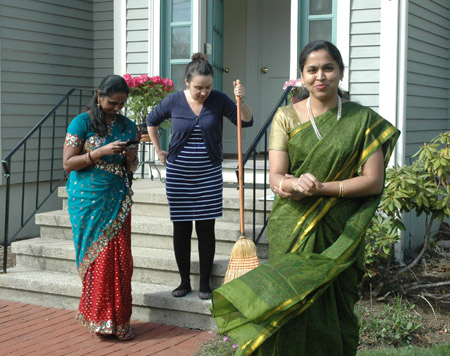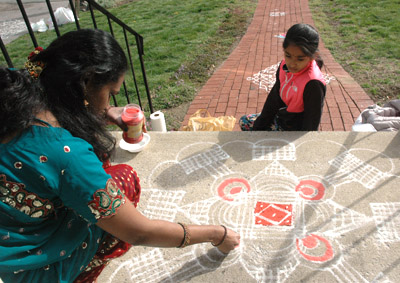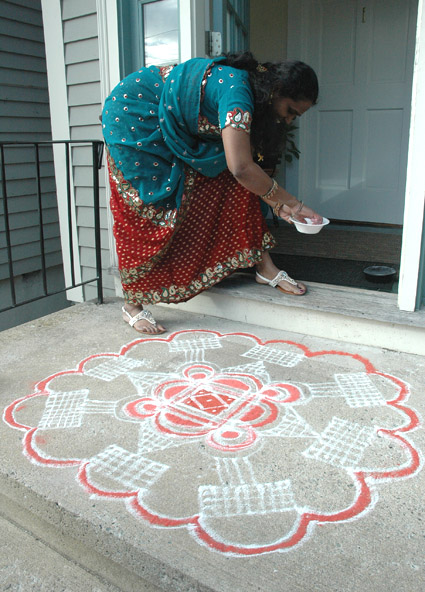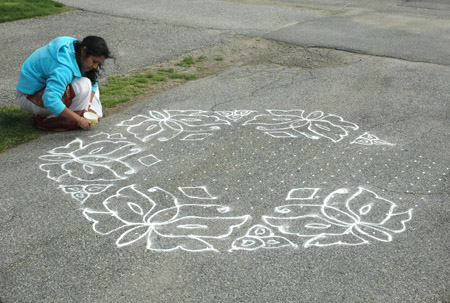As promised, here is a guest blog from MCC intern Nora Martinez-Proctor.
In early April, I set out to learn about the art of kolam and to find an artist or group who could show me what goes into creating these fabulous pieces. Kolam are designs made by dropping lines of colored rice flour on the ground at the thresholds of homes and temples throughout India. In the north, they are called rangoli and they have other names in other regions. They can be geometric and pattern-based or freehand, incorporating various types of iconography. The daily practice of creating kolam is a tradition that has reached across India for hundreds of years with mentions dating back to the Ramayana.
After several unsuccessful leads, I found my way to Tamil Makkal Mandram, Inc. TMM is a social and cultural group dedicated to preserving the arts and traditions of Tamil culture. The president of TMM, Karthekian Ramu, quickly set me up with several members of the group who were able to answer my questions and we had a wonderful afternoon with them in late April, observing their work and talking with them about their designs.
We met at the home of Maggie Holtzberg in Newton on a windy day (although, thank goodness, it didn’t rain!) Maggie and I weren’t sure what to expect, but as soon as Priya, Geetha, Sathya and Sridevi arrived dressed in beautiful, sparkling sari with everything they needed to create their kolam, we knew we were in for a fantastic afternoon! The artists immediately set to work figuring out the best spaces for their designs. Wanting to show us a range of kolam styles, they each planned to each complete one so that we could see examples from the most traditional to the most secular and celebratory. We talked with them as they worked and it was a pleasure to see the way these ephemeral pieces were created at close range.
As a violinist (my other day job), I particularly noticed the loose and yet efficient sweep of the women’s arms as they created the long, curved lines of the kolam. The amount of flexibility, relaxation and control needed is similar to what string players look for in their own arms, something that became especially interesting when I found out about the connection between kolam and cymatics. Cymatics is a visual-vibrational phenomenon where geometric patterns are derived from rhythmic motion (think about putting sand on a plate and then tapping the bottom of it and seeing waves appear). Geometric kolam designs are closely linked to cymatics in the idea that their patterns are similar to naturally occurring cymatic patterns, and that these “visual vibrations” are calming to the mind and encourage meditation.
One of the kolam with deep meaning was Geetha’s “Sikku” kolam. Sikku, meaning “knotted” is a traditional “everyday” kolam done without any color and made of a pattern of white lines curling around each other.
One of the most interesting things to learn here was that although the organized designs look impossibly complicated to create freehand, they are actually laid on a grid of rice flour dots which are then disguised or incorporated into the design as the artist follows the dots like a map. In India, Geetha explained to me, mothers teach the technique to their daughters starting with these counted dot patterns, which easily can reach over fifty dots per line and can then involve adding and subtracting from other lines to create the shape of the grid. I realized that all over South Asia, mothers are teaching their daughters math at a very young age through this technique. Pretty fantastic!
The interaction between mothers and daughters, and between all the women of the family, was something that all four women stressed as an extremely important part of creating kolam. I learned about this while watching Sridevi create a wildly colorful freehand design of peacocks and flowers that would not adorn a temple, but would be done in the streets.
During December and January, the gala season of Marghazi Maadham celebrates the art of kolam. For an entire month, the women of each household arise in darkness together and bring lanterns out into the chilly street, where they lay out their kolam and work to complete them by dawn. This is seen as a treasured time for the women to bond as they work. Mothers, grandmothers, daughters, sisters, and aunts all create the kolam and at dawn, Sridevi told me, they finish and go bathe before attending temple. Before temple, however, the street becomes an informal competition to see whose kolam is the biggest, the most colorful, and who was finished first. Sridevi added that the dawn bathing ritual is considered very healthy, and repeating it for a month is thought of as a cleansing and purifying ritual that is beneficial for women’s health in many ways. The designs during Marghazi are unique and creative and might appear in front of houses or even, as Sathya told me, in the road as a way to say “Happy Holidays,” to everyone!
In contrast, Priya created a holy design that is traditionally used at the threshold of temples or in front of deities. The design was done only in white and red, because these are the colors most closely associated with the colors of the temple. The central part, she explained, is the most important and the borders can be embellished or left simple, depending on the wishes of the artist and how much time they have to create.
Kolam vary widely and are often modified depending on the day, because they are a part of daily life and therefore designed to fit in with the other demands of the day. A busy day still requires a kolam, but it might be a small and simple design that takes a few minutes, whereas a holiday or other celebration would include more time set aside for a bigger and more complicated work.
The last design was splendid! Blending the aesthetic styles of several of the kolam, it was large in size, geometric and full of color. Sathya laid out a huge grid of dots to begin the design and then connected them into a pattern of flowers and butterflies.
As she worked, Sathya talked with me about what creating kolam means to her. Whenever she travels home to India, she told me, she tries to go during Marghazi so that she can have the pleasure of participating in creating kolam every morning with her family. She remarked that in New England, it is particularly difficult to practice this art because kolam are normally created outside – a tricky thing to do during a Massachusetts winter! In addition, the pace of American life is different from life in India, and does not lend itself as easily to a daily meditative art.
All four artists from the TMM expressed how pleased they were to set aside time on the day they met with us, not just in order to show us the kolam, but in order to enjoy creating the kolam themselves, something they rarely get to do in their American lives. Although a few solid days of rain soon washed away their fabulous work, Priya, Geetha, Sathya, and Sridevi were able to teach us that the joy of kolam is not only in its visual beauty but in the connections it keeps for them – connections of country and of family, of spirituality and all the meanings of home. As Sathya perfectly articulated gazing at her finished kolam, “I’m very happy today. My heart felt very happy today.”
Photos: Maggie Holtzberg










